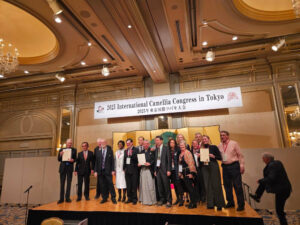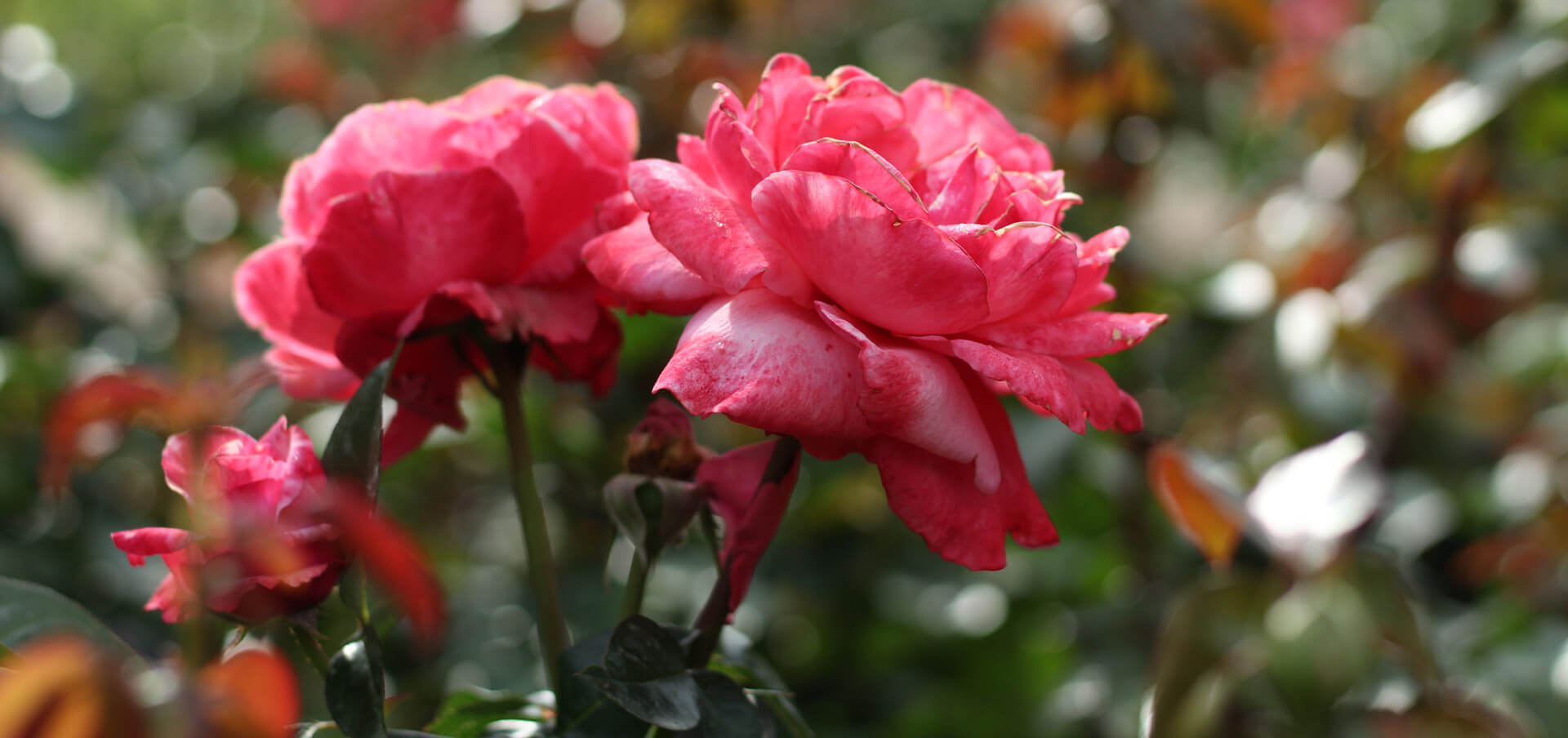Introduction: A Journey Across Japan’s Living Legacy
In March, I traveled to Japan to represent Bellingrath Gardens and Home at the International
Camellia Society’s Congress—an unforgettable opportunity to learn, connect, and celebrate the
rich history of camellias. With Bellingrath designating the camellia as a core botanical
collection, I focused on engaging with fellow camellia specialists and deepening my knowledge
of the genus through professional exchange and study.
The International Camellia Society, dedicated to education, research, and preservation, hosts a
Congress every two years in countries where camellias thrive. This year’s event in Japan was
especially meaningful, given that three of the four Camellia species native to the country—C.
japonica, C. sasanqua, and C. rusticana—have influenced thousands of ornamental varieties
worldwide.
In the first of three articles, I share highlights from the pre-Congress activities, along with the
insights I gained.
Day 1: Ishikawa Prefecture
A Warm Welcome and a Garden of Sublimity
We began our journey in Ishikawa Prefecture on the west coast of Japan, where our hosts
warmly welcomed us at the Shiinoki Geihinkan. The opening ceremony featured a koto
performance—a traditional Japanese lap guitar and the national instrument of Japan—followed
by a camellia show.
Local camellia organizations gather blooms from their gardens during the winter months for display and judging based on the ideal characteristics of each variety. In the United States, participants traditionally place a single flower with a leaf in a shallow glass dish. In contrast, in Japan, they arrange entire stems with one or more flowers and leaves in ornamental vessels, enhancing the bloom’s splendor and creating a striking presentation (pictured below).
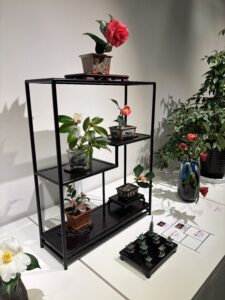
After the warm welcome, we took a short walk to the Kenrokuen Area Cultural Zone. “Kenrokuen” translates to “Garden of the Six Sublimities,” reflecting the ancient Chinese principles of the ideal garden: spaciousness, seclusion, artificiality, antiquity, abundant water, and broad views.
Although camellias were not present in overwhelming numbers, immaculate attention to detail
revealed itself at every turn. For instance, instead of allowing pine trees to shed their needles
naturally, gardeners meticulously remove the previous year’s needles by hand—a practice
known as momiage—giving the trees a fresher, more vibrant appearance. They also build
intricate structures around the trees to support the branches during snowfall.
One of the most remarkable sights was the Karasaki Pine, a tree that began as a seedling centuries ago and has since been carefully trained to stretch over a pond. Each winter, gardeners install rope- like supports to protect its sprawling branches—a breathtaking tradition and a testament to centuries of dedication (pictured below).

Day 2: Toyama Prefecture
Cultivating Camellia Culture from Classroom to Conservatory
After an incredible start to the Congress, we spent the following day in Toyama Prefecture, visiting the Inokuchi Camellia Center and the Botanic Gardens of Toyama. At the Inokuchi Camellia Center, I found it inspiring to see how deeply the people of Nanto City value the camellia. Local school children welcomed us with a presentation, sharing how they learn from an early age to appreciate the flower, practice propagation, and even explore the basics of breeding attractive new camellia varieties.
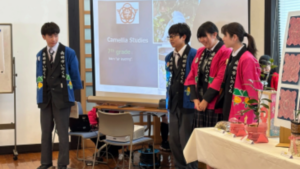
Beyond serving as a hub for breeding and research, the Inokuchi Camellia Center acts as a
cultural gathering place for the community. Artworks celebrating the camellia fill the building,
and several multifunctional rooms and outdoor recreational areas offer space for public use,
creating an atmosphere that celebrates both the camellia and the spirit of the community.
After spending the morning at the Inokuchi Camellia Center, we took a bus to the Botanic Gardens of Toyama, where we explored a conservatory filled with Chinese species of camellia. I found the signage particularly impressive, which displayed a picture of each bloom along with the scientific name and variety in multiple languages—making the learning experience easily accessible to all. It was here that I first encountered something straight out of a Dr. Seuss book: towering ten-foot columns of reeds. These structures protect plants during winter—specifically Cycas revoluta. While we might use blankets or plastic in the U.S., Japan wraps plants in rolls of reed, offering both protection from the cold and an aesthetically pleasing form.


Day 3: Ishikawa and Tokyo Prefectures
From Labyrinthine Gardens to Urban Oasis
Next on our whirlwind journey, we visited Nonoichi City and Tokyo. In Nonoichi City, we toured Nonoichi Central Park, one of Japan’s eight Gardens of Excellence. The International Camellia Society awards this prestigious accreditation to gardens that meet strict criteria, including a high number of unique Camellia taxa and proper signage and record-keeping. I was particularly struck by the garden’s layout: they displayed 1,700 camellia specimens in two ways—Tsubaki Kan, a pavilion for exhibitions, and Tsubaki Yama, an artificial hill where camellias grow in a labyrinth.
Later that day, we traveled to Tokyo via the Shinkansen, or bullet train. Whizzing through the landscape at 200 miles per hour (320 kilometers per hour), I watched the surroundings rapidly shift from mountainous countryside to urban sprawl—an experience that felt surreal.
Upon arrival, we stayed at the luxurious Hotel Chinzanso Tokyo. Though founded in 1992, the hotel is nestled within a spectacular 700-year-old garden, historically referred to as ‘Camellia Mountain’ in ancient texts due to its wild camellia stands. One of the garden’s most captivating features is its innovative nighttime transformation: instead of closing, it becomes a technicolor display of lights, with fog released every fifteen minutes to create an ethereal atmosphere.
While at Chinzanso, we held the official welcome ceremony, where the Governor of Tokyo, Ms. Yuriko Koike, and Her Imperial Highness Princess Hisako Takamado made special appearances. Princess Takamado shared a fascinating story about birdwatching: she observed that the native warbling white-eye prefers feeding on the C. japonica rather than the showy cultivars. One possible explanation for this preference is that the white-eye recognizes the native, single red flowers as a food source, while the showier cultivars might appear alien to them.
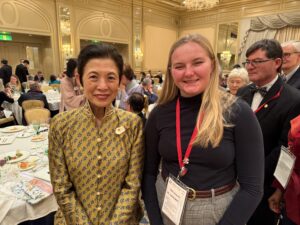
At the event, I also had the pleasure of meeting Professor Wang Zhonglang, the International Camellia Registrar, who oversees the International Camellia Registry—a comprehensive database with tens of thousands of Camellia taxa. This resource has been instrumental in my work to revitalize Bellingrath’s camellia collection, helping me identify unknown varieties, uncover cultivar histories, and confirm existing identifications.

Conclusion: Looking Ahead
Applying Lessons from Japan to Bellingrath’s Future
After visiting so many incredible locales and connecting with fellow camellia enthusiasts, I was
struck by the profound relationship the Japanese have with the camellia. I not only discovered
hundreds of new cultivars bred in Japan but also saw how a fascination with the genus is
nurtured from a young age, ensuring the continuation of camellia culture. I look forward to
applying what I’ve learned from this journey to advancing Bellingrath’s camellia collection as we
move forward with our critical recovery efforts.
In next month’s installment covering the International Camellia Society’s main Congress, join me
as we discuss Oshima Island’s intimate and ancient history with the camellia as well as the
deeply personal Camellia Gardens of Ito City!
